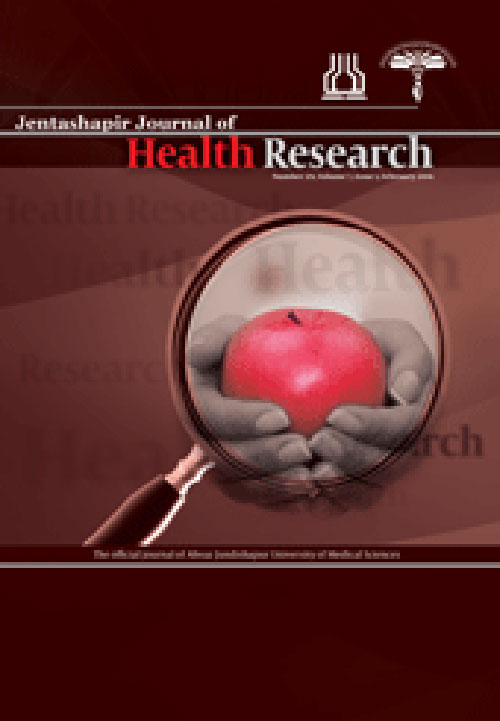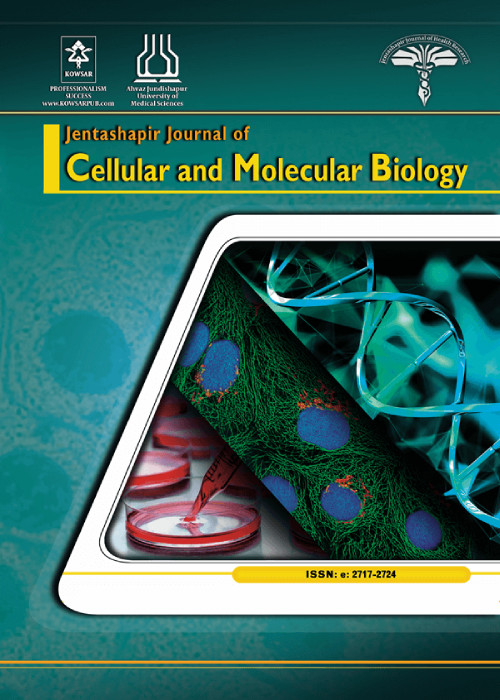فهرست مطالب

Jentashapir Journal of Cellular and Molecular Biology
Volume:8 Issue: 6, Dec 2017
- تاریخ انتشار: 1396/10/10
- تعداد عناوین: 8
-
-
Page 1BackgroundPatients often complain about the esthetic problems of gingival pigmentation. The aim of this study was to compare the effectiveness and recurrence of diode laser 810 nm and cryosurgery for gingival depigmentation.MethodsA total of 12 patients with physiologic gingival pigmentation were selected. The inclusion criterion was the presence of gingival pigmentation of maxillary incisors and the exclusion criteria was the presence of systemic diseases or use of any drugs associated with gingival pigmentation. For further evaluation, photographs were taken before and after treatment within the same position and light. Color analysis was done using the Adobe Photoshop software. Patients were treated by diode laser 810 nm - 2 w and on the opposite side cryosurgery was performed. Treatment was done under topical anesthesia if required. The laser beam was activated using the brush technique and in contact mode. Application period differed according to the degree of melanin pigmentation and epithelial thickness of the treated area. Cryosurgery was performed by a cotton swab. The swab was gently touched and rolled on the area for 10 to 15 seconds until the disappearance of gingival pigmentation. All patients were examined 1, 3, and 6 months after treatment.ResultsData were analyzed using the SAS software version 19. The degree of pigmentation was considered as follows: score1: mild pigmentation, score 2: average pigmentation, and score 3: intense pigmentation. The treatment of gingival pigmentation with laser and cryosurgery showed marked improvement of gingival pigmentation in both methods as well as no significant difference between the 2 methods after 1, 3, and 6 months of treatment.ConclusionsBoth methods are appropriate for the treatment of gingival depigmentation and no significant recurrence was observed during the 6 months follow - up.Keywords: Gingival Depigmentation, Diode Laser, Cryosurgery
-
Page 2Background And ObjectivesDental implant is a method to replace missed teeth, and especially for aesthetic it is important to replace the missing anterior teeth. Thus, in this study, for replacement of 6 maxillary anterior teeth by finite element analysis (FEA) method, stress distribution around implants in 3 models of maxillary arch were compared.MethodsIn this in-vitro study, a toothless patients CBCT was used to create a model for maxillary anterior teeth. The ITI dental implant with a 10-mm length and 4.1-mm diameter was used to replace central and canine teeth.
Using the ABAQUS software, simulation was performed for reconstruction of 6 maxillary anterior teeth, so that 2 implants were placed on both sides of the canine tooth region (model A); 2 implants on both sides of the canine tooth region and another on one side of the central region (model B); as well as 2 implants on both sides of the canine tooth region and 2 implants in the central area (model C). These models were repeated in the triple square, ovoid, and tapering arches. In all cases, a 100-N force with a 30-degree angle was imposed buccolingually to each veneer to simulate the functional forces. Data were then analyzed by the finite analysis software, ABAQUS.ResultsBy applying a 100-N force under a 30-degree angle, along with the increase of implants number, von Mises stress in the models was reduced. In a comparison of models A in each maxillary arch, the stress created in the cortical and cancellous bones in the square arch was less than ovoid and tapering arches. In addition, in a comparison between models B and C in the 3 maxillary arches, stress in the cortical and cancellous bones in the tapering arch was less than square and ovoid arches. The stress created in implants and cortical and cancellous bones in model C was less than the A and B models.ConclusionsThe results show that unlike 2- or 3-implant models, in the 4-implant model, the stress distribution was reduced in cortical and cancellous bones.Keywords: Dental Implant, Finite Element Analysis, Canine to Canine Bridge, Maxillary Arch -
Page 3BackgroundDeath depression is one of the components of death-related distress, characterized by a form of sadness related to the individuals death, other peoples death, and/or the concept of death in general.ObjectivesThe current research aimed to investigate death obsession, death anxiety, and depression as predictors of death depression among married nurses in Iran.MethodsThe sample consisted of 146 married female nurses from different wards of governmental hospitals, as well as Mehr and Arya private hospitals, affiliated to Ahvaz Jundishapur University of Medical Sciences. The participants responded to the death depression scale-revised (DDS-R), death anxiety scale, death obsession scale, as well as the short-form of Beck depression inventory (BDI-13).ResultsThe findings indicated that death obsession, depression, and particularly death anxiety (β, 0.47), were predictors of death depression. The three predictive variables could explain 0.62 of variance in death depression.ConclusionsDifferent factors can affect death depression, including obsessions and anxieties related to death. Therefore, these concerns should be reduced dramatically in hospital settings, as stressful environments.Keywords: Depression, Obsession, Anxiety, Nurses
-
Page 4BackgroundOral lichen planus (OLP) is a chronic inflammatory disease with muco - cutaneous involvement and unknown etiology. Endothelin1 (ET - 1) is a potent vasoconstrictor peptide, which is associated with some inflammatory diseases. The present study aimed at measuring and comparing the salivary level of ET - 1 in patients with OLP.MethodsThe current case - control study included 20 Iranian patients diagnosed with OLP as the case and 20 age - sex - matched healthy volunteers as the control groups. All the participants signed the informed consent form before recruitment. The ET - 1 level in whole unstimulated saliva (WUS) was determined by the enzyme - linked immunosorbent assay (ELISA) technique. Statistical analysis was conducted using ANOVA and t test.ResultsThe mean salivary ET - 1 level in patients with OLP showed no significant difference compared with that of the control group (24.67 ± 12.07 pg/mL vs. 26.83 ± 7.73 pg/mL; P > 0.05). There were no significant difference in the salivary ET - 1 level between the reticular and erythematous - erosive groups (23.31 ± 9.12 pg/mL vs. 25.78 ± 13.99 pg/mL; P > 0.05).ConclusionsThere were no significant differences in terms of the salivary ET - 1 level between the OLP and control groups.Keywords: Oral, Lichen Planus, Saliva, Endothelin 1
-
Page 5BackgroundDental plaque is considered as the main factor of periodontal diseases. The use of mouthwashes is one of the most effective chemical methods for inhibiting plaques.ObjectivesThis study aimed at evaluating the effect of Chlorhexidine (CHX) and Jaftex mouthwashes on periodontal indices.MethodsIn this double blind intervention, 20 male dental students were selected and randomly divided to two groups: 1) Group A: In this group, participants were given chlorhexidine mouthwash; 2) Group B: In this group, participants were given Jaftex mouthwash. Students were asked to use 15 cc of mouthwash, which they received, two times a day (each time for two minutes) for two weeks. Before taking the mouthwashes and two weeks later, the students were examined and the plaque index, gingival index, and tooth staining index were recorded. Independent t-test was used for data analysis.ResultsBoth CHX and Jaftex reduced the amount of plaque and gingival indices (P 0.05%). Furthermore, CHX and Jaftex increased the staining and the intensity of the stained area indicators yet the amount and intensity of the staining in the use of CHX was more, and the difference was not statistically significant.ConclusionsJaftex is a herbal mouthwash that is effective on periodontal indices and it is recommended that patients use it for chemical inhabitation of plaques.Keywords: Chlorhexidine, Jaftex, Mouthwash, Periodontal Index
-
Page 6ObjectivesCRP (C - reactive protein) is more often used to show hidden infections with the bacterial origin. CRP is most likely activated due to bacterial infection. The researcher in this study examined the effect of selenase on acute phase protein response.MethodsIn this clinical trial, all patients were men and women in the age range of 20 - 90 years old who were suffering from septic shock and the presence of positive bacterial cultures, Peoria, positive radiographic abscess, pneumonia, cellulites, gangrene, and infection in the presence of a urinary catheter that since the adoption of the proposal were admitted. To evaluate the mean level changes of plasma variables in the two groups, t-student test was used. The software used for statistical analysis was SPSS-18 and statistical values less than 0.05 were considered significant (PResultsLaboratory findings where markers of the acute phase response were examined in this study include the increased platelet count and CRP. Both variables in the two groups were statistically significant (PConclusionsEffect of the acute phase response for detection infection in patients with sepsis is still controversial. This study showed the positive effect of Selenium on patients who have suffered from septic shock.Keywords: Sodium Selenite, Patient, Acute-Phase Protein, Plasma
-
Page 7The aim of this study was to evaluate the antimicrobial effects of essential oils (EOs) isolated from Myrtus communis L. (myrtle) against Streptococcus mutants, Streptococcus sanguis, and Streptococcus salivarius through in vitro experiments. The EOs was isolated from myrtle leaves by the hydrodistillation method. The disc diffusion method was used to evaluate the zone of microbial growth inhibition by different concentrations of the EOs. The inhibition zone for all concentrations was measured in diameter (MM) after incubation at 37° for 18 hours. According to these measurements, the Minimal inhibitory concentration for each bacterium was reported. Tetracycline and erythromycin were used as positive control. The result showed that EOs of myrtle leaves had antimicrobial activity on disk-diffusions plates against all strains of Streptococcus, which were tested; however, S. mutants showed greater susceptibility than others. EOs of myrtle leaves could be recommended as a potential remedy for prevention the colonization of teeth by Streptococcus mutants and hinder the development of dental caries.Keywords: Myrtus, Streptococcus, In Vitro, Dental Caries
-
Page 8IntroductionBackground And ObjectivesPrimary congenital glaucoma (PCG) (OMIM: 231300) is an inherited ocular illness, which leads to permanent blindness. Up to now, three dissimilar loci are mapped for PCG. The most common locus detected for this disease is cytochrome P450 (CYP1B1; GLC3A) mutations. Expression and penetrance of PCG varies from 40% to 100%. It seems the high incidence in the oriental communities is due to consanguineous matrimonies. PCG happens in both sporadic and familial patterns. Inheritance in familial cases is usually autosomal recessive, which sometimes manifested as incomplete penetrance. Pseudo - dominant transmission was also reported.Case PresentationThe paper reports a case of genetic counseling in Iran that the client couple had family marriage and demanded pre-pregnancy consultation, but the male was healthful and unaware of treated genetic disorder in his infancy. After history taking, the first candidate gene (CYP1B1) in the husband and his parents were amplified by polymerase chain reaction (PCR), sequenced using Sanger technique; therefore, the control subjects and patients were analyzed to identify PCG mutations.ConclusionsThe husband and his mother were compound heterozygote for CYP1B1 gene mutations including two variations in 61 and 368 codons. Also his father was heterozygote for one variant. More investigations showed that the wife (husbands cousin) did not mention mutations. The local certified counselor/physician provided genetic counseling, should investigate surgery reason and its description for individuals with therapeutic or plastic surgery history. This early and reliable diagnosis of the disease is vital for the next generation, especially in family marriage cases, prenatal diagnosis is provided, also, appropriate and early medical and surgical prognoses can be performed. This causes prevention of visual loss and save vision of the child.Keywords: Genetic Counseling, Glaucoma, CYP1B1 Gene, Consanguineous Marriage


